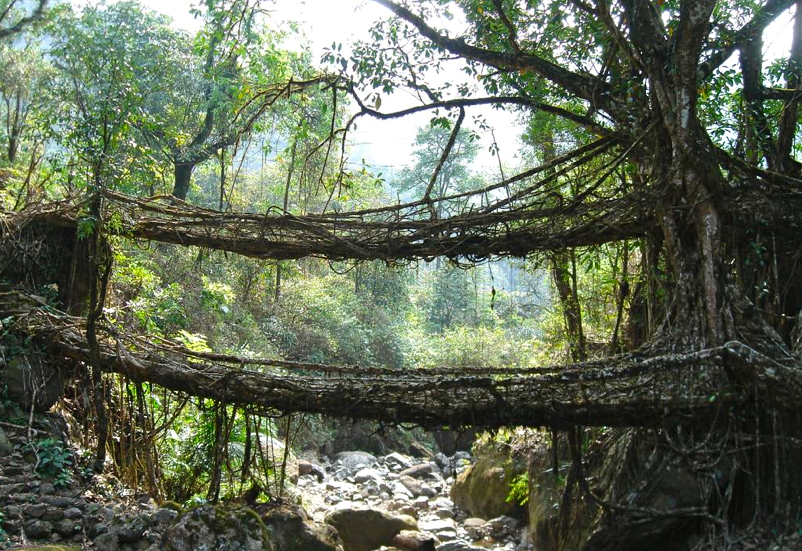

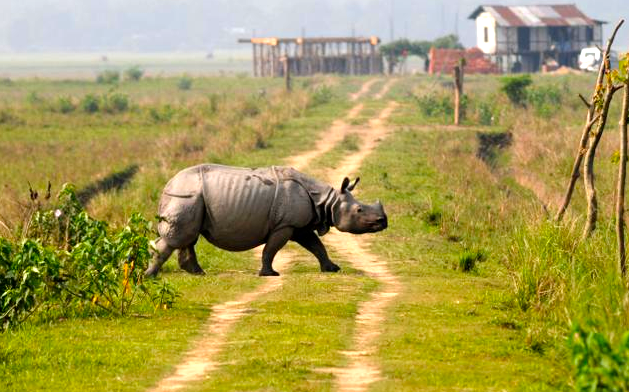




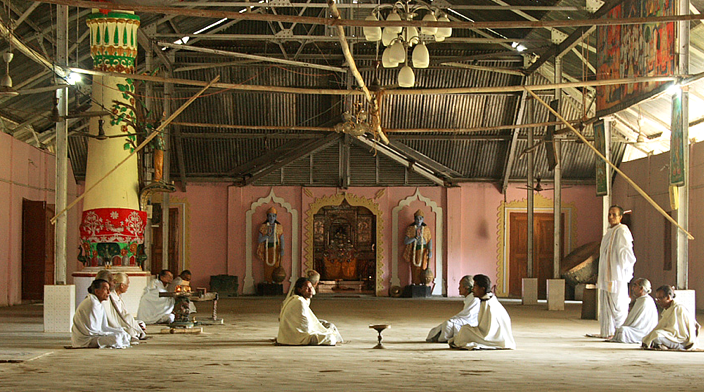



















It was summer and we had just graduated after three wonderful years in college. We wanted to spend one last time together with a trip to the north eastern part of India. This region had always been so alien to all of us and we thought it was time for us to explore it. Little did we realize that our trip would take us to some what were arguably some of the most beautiful parts of the country.
Our journey to the north eastern part of India began with with a short flight from the city of Kolkata to Guwahati. Guwahati is one of the largest cities in the north eastern part of India. We had had enough of the city life and so we proceeded directly to Kaziranga National Park which is 230 kms away.

A world heritage site, Kaziranga is inhabited by the world's largest population of one-horned rhinoceroses as well as many mammals, including tigers, elephants, panthers and bears, and thousands of birds. The landscape of Kaziranga is of sheer forest, tall elephant grass, rugged reeds, marshes & shallow pools. We went on an early morning elephant ride in search of the rhino. The elephant safari is one of the best ways to explore the wide varieties of wildlife in the Kaziranga National Park .The vast area covered by the Elephant Grass can be best viewed when you are on an elephant's back. Here you get an opportunity to see herds of Indian Elephants, One-horned Rhinoceros and many other wild animals from a very close distance. After spending about 2.5 hours on an elephant, we embarked on a 4 hour jeep safari of the Central Range of the Park. While the elephant safari enables you to get real close to the animals specially a rhino, a jeep safari takes you deeper into the forest range where you can spot many more animals and birds. If you are especially lucky, you may even spot a tiger while on your jeep safari.





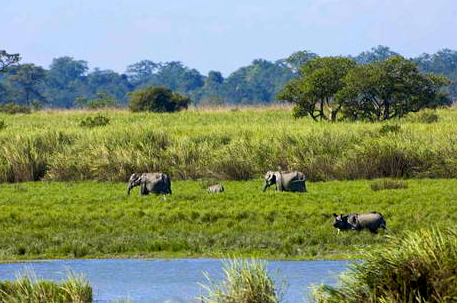
The next day, after an early breakfast, we drove to Nimatighat and then cruised to Majuli Island which is the largest river island on earth. It is pollution free and is a haven for natural beauty with abundant flora and fauna. In the afternoon we visited the Satras. Satras in Assam are basically monasteries which were established to propagate neo-Vaishnavism. Majuli is one of the major seats of several Satras established by Vaishnava revivalist, Sankardeva. There are about 22 Satras in Majuli. We explored the little villages around the Satras. We were fortunate enough to get the chance to spend the night with one of the families in the village. Early the next day we took the ferry to the mainland from where we proceeded to Jorhat which was 3 hours away.
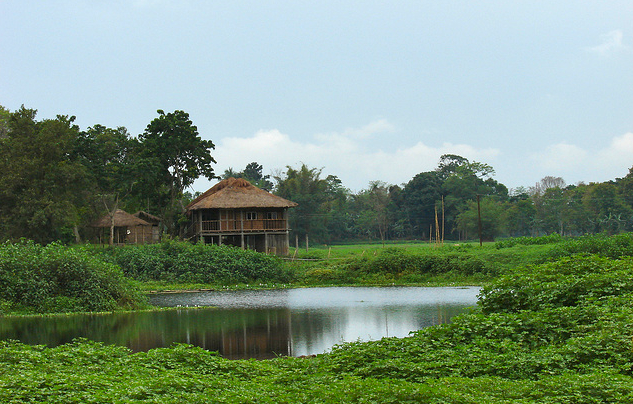


We didn't spend much time at Jorhat. We had a quick lunch after which we drove to Mokokchung - the Ao country of Nagaland which was 130 kms away. It took us 4 hours to get there.
Mokokchung is the cultural hub of the Ao people. You can visit the many churches all around the town. Or if you want to understand the art, history and culture of the place, you should head out to the Mokokchung District museum in the Arts and Cultural Complex. The museum display exhibits various artifacts of Ao Naga tribe such as swords, shield, shawl, clothing, traditional jewelry, accessories and more. We spent 2 nights at Mokokchung, and explored the Ao Naga Villages in and around the region.

On day 6, we proceeded to Mon which was 220 kms or 8 hrs away. Home of the Konyaks, the town was established at the land of Chen and Mon villages. Situated at an altitude of 2,945 ft above sea level, it is centrally located for the coronation of Anghs (chiefs).
The place has always evoked a sense of awe and wonder in the minds of people. Colourful life and culture are an integral part of the 16 officially recognized Naga tribes of Nagaland. These 16 tribes are different and unique in their customs and traditions. These customs and traditions are further translated into festivals which revolve around their agricultural cycle. Songs and dances form the soul of these festivals through which their oral history has been passed down the generations.



After two days at Mon we drove to Dibrugarh which was 200 kms or 7 hrs away. Situated in the northernmost tip of Assam, Dibrugarh is the gateway to Aurnachal Pradesh. Famous for tea, it has world’s largest area covered by tea gardens. After the long drive, all we could do is rest and prepare for the journey ahead.

After an early breakfast, we cruised on the Brahmaputra to Pasighat. It took us more than 7 hrs to get there. The oldest city of Arunachal Pradesh, this city is the entrance point for Arunachal Pradesh. We spent the night at Pasighat.

The next day we drove down to Along (147 kms/5 hrs), the land of Adi Gallong tribes of Arunachal Pradesh. Located at an altitude of 300 m above sea level, Along is the headquarters of the West Siang district of Arunachal Pradesh. The idyllic town lies nestled in a picturesque valley, surrounded by lofty mountains and the beautiful rivers of Sipu and Siyom.
Here we visited one of the largest Gallong tribal village called Dwarka village which has more the 1500 houses made of bamboo and palm. Enroute you can enjoy the great view of Siang River and Syiom River confluence. We spent the next day exploring Along. We went to Kabo Village which is situated on the banks of Yomgo/Siyum River. We also checked out the hanging bridge which is made of cane and bamboo on the River Yomgo. This is a spectacular architecture marvel and you definitely have to see it to believe it. Later we trekked to the farmer's country towards Tuting.


The next day we drove to Daporijo (176 kms / 7 hrs) - land of Tagin and Hillmiris tribes of Arunachal Pradesh. The small town is endowed with scenic beauty. The suspension bridges over Subansiri River made from bamboo and cane is testimony of the rich tribal craftsmanship. Subansiri River is ideal for river rafting and that is exacty what we did.


The next day we drove to Ziro - the land of Apatani Tribes of Arunachal. Here we visited the Hong Village. We then explored the Apatani villages and Nishi tribal Village which are not too far away. The uniqueness of the Apatani tribe is tattooing on the women's face and their nose plug. Apatani, like other tribes also believe in sun and the moon as god and have traditional altar in their home made up of Bamboo and Cane. After a whole day of exploring we spent the night at Ziro.

The next day we drove to a tea estate in Tezpur (310 kms/7 hrs). Situated on the north bank of the Brahmaputra, Tezpur is a beautiful and multifaceted city steeped in mythology and history. The city abounds in archaeological sites, hills, lakes and gardens.

From Tezpur, we drove down to Dirang - the land of Monpas of Arunachal Pradesh (160 kms/6 hrs). Enroute we visited Tipi Orchid Park. Situated on the banks of the Bharali River, Tipi is known for the widest assortment of orchids found in India. It is astonishing to know that more than 500 species of orchids are found here. Later we drove on towards Sherdukpen tribal village at Rupa before moving onto Dirang.
Located in a spectacular valley, Dirang is famous for its apple orchards, sheep breeding farms and natural hot springs. The hot water springs in Dirang is considered holy by many who travel to them for a dip. Dirang is ideal place for adventures like trekking and hiking.

The drive to Tawang from Dirang is spectacular and one of the highlights of the entire journey. We stopped briefly at the Sela pass at 14000 ft. From Sela, the road goes downhill. Enroute we passed Jaswantgarh. It’s a memorial to Jaswant Singh PVC of the Indian Army who single-handedly repulsed a Chinese attack but fell bravely defending his position. We also visited Sange village before entering Tawang.
Here we enjoyed a full day of excursion including a visit to the famous Tawang Monastery. The 300 year old Monastery, locally called "Gompa" is considered to be the oldest in India and second largest Monastery in Asia after Lhasa in Tibet. The Monastery stands on the spur of a hill over 12000 ft. above the sea level. It accommodates over 500 monks and houses priceless Buddhist texts and scriptures. The Tibetan influence here is unmistakable, with the elaborately painted wooden windows and other motifs. Prayer flags flutter in the breeze and inside, the monks light lamps and drone in joint prayer. An 8mt high gilded statue of the Buddha is seated here, as are numerous ancient Thankas or traditional paintings and manuscripts. We also visited the high altitude lakes including Pangong Tang Tso Lake (commonly referred to as PT Tso Lake).

After a spectacular 18 days, it was time to begin our return journey which would take another 6 days. Our return journey began with a drive to Dirang. Here we went on a trek to Sangti Valley. Situated along the shores of Sangti River, 25 km from Bomdila near Dirang, the Sangti Valley is one of the seasonal homes of the majestic creature called the black-necked crane that flies across from China and perhaps Leh, right into its laps. Later we visited the Sheep Breeding Centre, Dirang Dzong. After 2 days at Dirang, we drove down to Tezpur which was 6 hrs away. After an early breakfast the next day we drove to Shillong (300 kms/7 hrs). Termed as “Scotland of the East”, Shillong is situated at a height of 5,000 feet on the plateau of gentle hills. Cool colonnades of tall pine trees clad with whispering green leaves glistening in the sun surround the city. On its bosom lie several lovely waterfalls – Spread Eagle falls, Elephant Falls, Beadon Falls etc. sprightly dancing down from their hilly heights. Shillong with its veritable beauty spots like Ward’s Lake, the Lady Hydari Park with its mini zoo, and its 18-hole Golf Course, one of the oldest and best in the country, is a great tourist center. The next day we drove to the Mawpflang Sacred Forest and visited some scenic Khasi villages. We visited the largest traditional Market - Bara Bazar or as the locals call it, the Lewduh Market. In the evening, we went and watched the traditional Archery event near Polo Ground of Shillong.


This was the last day of our trip. We drove to Cherrapunjee (56 kms /3 hrs), the 2nd rainiest place in the world. This lovely town is also famous for its limestone caves and orange honey. En route we visited Elephant Falls, Shillong Peak, which at 1965 m is the highest point in Meghalaya. On reaching Cherrapunjee we visited Mawsmai Cave, Mawsmai Falls, Nohkalikai Falls, the fourth highest fall in the world, Thankarang Park from where you get a panoramic view of Bangladesh and Khrem falls. After an exciting day we drove back to Shillong where we spent the night. The next day we packed our bags one last time and headed back home after what has been one of the most grueling and beautiful journeys of our lives.

